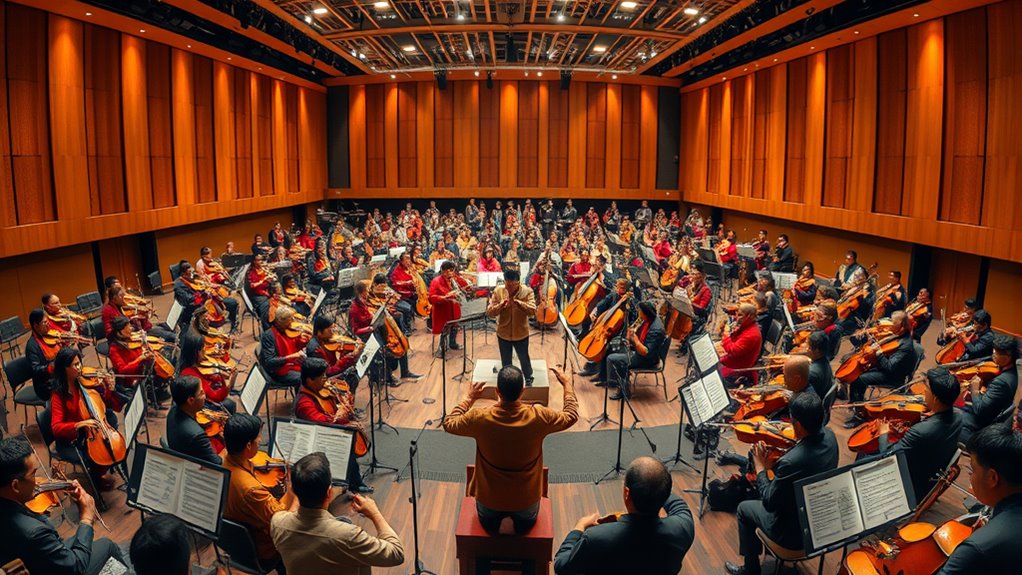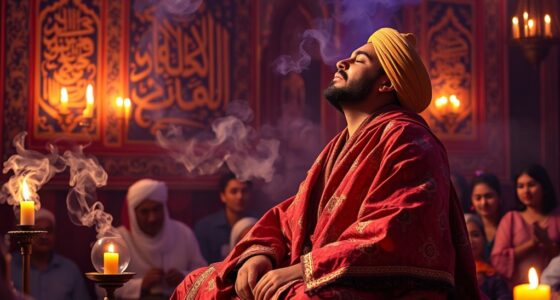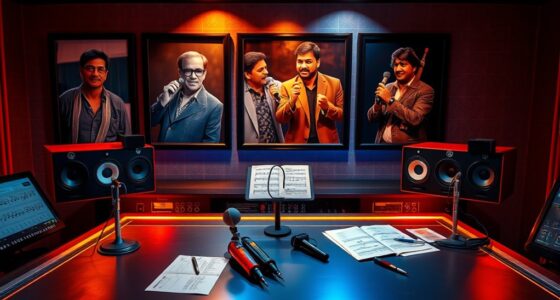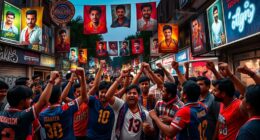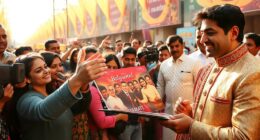To record a Bollywood score with a 200-piece orchestra, you coordinate detailed arrangements, selecting how each instrument complements others for a vibrant sound. You schedule multiple recording days, set up the hall with ideal microphones, and guarantee all musicians are ready. During the session, you oversee microphone placement, monitor performances, and make quick adjustments. The process balances artistic direction with technical precision, and if you keep going, you’ll discover how every step ensures a grand Bollywood sound.
Key Takeaways
- The process involves meticulous arrangement, balancing multiple instrumental layers to create Bollywood’s vibrant soundscape.
- Recording sessions are carefully scheduled, often spanning several days with a large orchestra in a suitable hall.
- Microphone placement and instrument setup are optimized for capturing the full depth and vibrancy of the orchestra.
- Conductors and sound engineers work together to monitor takes, ensuring synchronization and high-quality sound capture.
- Post-recording involves detailed mixing and editing to enhance the cinematic impact and emotional tone of the score.
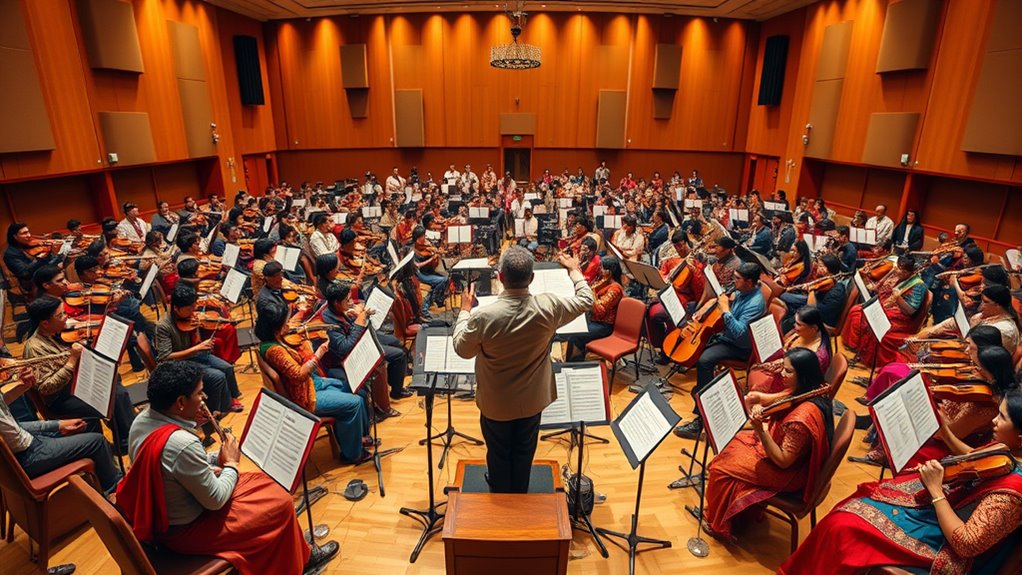
Capturing the grandeur of Bollywood music often requires more than just talented singers and composers; it demands a massive orchestral effort. When you step into a recording session for a Bollywood score involving a 200-piece orchestra, you realize that every detail matters. The process begins with meticulous music arrangement, where composers and arrangers craft the intricate layers of sound that will fill the theater. This stage is vital because it determines how each instrument complements the others, creating the lush, vibrant textures characteristic of Bollywood music. You work closely with arrangers to guarantee that every note, harmony, and rhythm aligns perfectly with the emotional tone of the scene.
Once the music arrangement is finalized, you turn your attention to session logistics. Coordinating a session of this scale isn’t simple; it involves scheduling multiple days, securing a suitable recording hall, and managing a large team of musicians, engineers, and conductors. You need to verify that each musician knows exactly when and where to be, what parts they’ll play, and how their performance fits into the overall score. Clear communication and detailed planning are essential—any misstep can delay the entire process or compromise the quality of the recording. You also arrange for the necessary equipment, microphones, and sound engineers to capture the full depth of the orchestra’s sound.
On the day of recording, you oversee the setup, making sure each instrument is miked correctly and positioned to optimize sound capture. The conductor leads the musicians, but your role involves fine-tuning the session logistics—monitoring timing, managing multiple takes, and making real-time adjustments. During recording, you keep track of progress, ensuring that the musicians stay synchronized and that the sound engineers capture the best possible performance. This stage demands rapid decision-making; if a section isn’t quite right, you coordinate a re-take without wasting valuable time.
Throughout the process, your focus remains on maintaining the integrity of the music arrangement, guaranteeing that every note contributes to the emotional and cinematic impact. You’re responsible for balancing the technical aspects with artistic sensibilities, all while managing the complex logistics of a large-scale session. Ensuring the quality of the recording also involves understanding the importance of sound engineering, which plays a crucial role in capturing and shaping the orchestra’s full vibrancy. When the recording wraps up, you oversee the mixing and editing process, shaping the final sound that will bring Bollywood’s vibrant storytelling to life. Every step hinges on your careful planning, precise execution, and unwavering attention to detail—ensuring a spectacular orchestral performance that captures Bollywood’s grandeur.
Frequently Asked Questions
How Are the Tempo and Rhythm Synchronized Across Such a Large Orchestra?
You guarantee tempo and rhythm stay synchronized by relying on precise conducting techniques and advanced studio technology. The conductor uses clear cues and baton movements to guide the orchestra, maintaining unity. Modern studio tech, like click tracks and digital metronomes, helps keep everyone in sync. Together, these tools and techniques create a seamless performance, even with a 200-piece orchestra, ensuring the score sounds perfectly coordinated.
What Criteria Determine the Choice of Instruments for Bollywood Scores?
You choose instruments for Bollywood scores based on their sound qualities and the story’s emotional tone. Cultural influences play a big role, guiding you to select traditional instruments like the sitar or dhol alongside modern ones. You consider how each instrument’s unique voice enhances the mood, ensuring the score resonates with the audience. Ultimately, your goal is to blend cultural authenticity with musical versatility to create a mesmerizing soundtrack.
How Are Individual Musician Performances Integrated Into the Final Score?
You coordinate musician collaboration carefully, ensuring each performer’s part aligns with the conductor’s vision. During score integration, the conductor and music director blend individual performances, adjusting timing and dynamics to create a cohesive sound. You listen critically, guiding musicians to synchronize perfectly. This process transforms separate performances into a seamless, polished final score, capturing the essence of the composition and enhancing the emotional impact of the Bollywood soundtrack.
What Challenges Arise in Recording Live Sound in a Large Orchestra Session?
When recording a large orchestra, you’ll face challenges ensuring sound quality and musician coordination. Balancing multiple instruments requires precise microphone placement and sound mixing to capture clear audio. Keeping 200 musicians synchronized can be tough, especially in a live setting. You’ll need careful conducting and communication to maintain timing, while technical adjustments help improve sound clarity. These factors are essential for producing a seamless, high-quality Bollywood score.
How Is the Final Mixing and Mastering Process Handled for Such Recordings?
You handle the final mixing and mastering by collaborating with sound engineers who focus on audio editing and sound engineering. They fine-tune individual tracks, balance levels, and add effects to guarantee clarity and cohesion. You review the rough mixes, give feedback, and approve the final version. During mastering, they optimize sound quality for various playback systems, ensuring your Bollywood score sounds vibrant and polished across all formats.
Conclusion
You now see how recording Bollywood scores with a 200-piece orchestra creates rich, layered music that captures the essence of each scene. For example, imagine a romantic song where the orchestra’s crescendo elevates the emotion, blending traditional instruments with modern sounds. This intricate process, involving precise coordination and expert musicianship, guarantees each score resonates deeply with audiences worldwide. It’s a proof to the artistry behind Bollywood’s unforgettable soundtracks.
